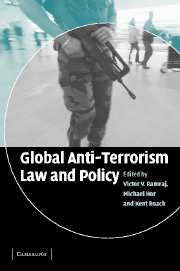Book contents
- Frontmatter
- Contents
- List of contributors
- Acknowledgements
- 1 Introduction
- PART ONE Theoretical Perspectives on Anti-Terrorism Law and Policy
- PART TWO A Comparative Study of Anti-Terrorism Measures
- PART THREE Anti-Terrorism Law and Policy in Asia
- 13 Law and terror: Singapore stories and Malaysian dilemmas
- 14 Indonesia's Anti-Terrorism Law
- 15 The Philippines: the weakest link in the fight against terrorism?
- 16 Japan's response to terrorism post-9/11
- 17 Legal and institutional responses to terrorism in India
- 18 Enacting security laws in Hong Kong
- PART FOUR Regional Cooperation
- PART FIVE Anti-Terrorism Law and Policy in the West
- PART SIX Anti-Terrorism Measures in Africa, the Middle East and Argentina
- Index
17 - Legal and institutional responses to terrorism in India
Published online by Cambridge University Press: 21 July 2009
- Frontmatter
- Contents
- List of contributors
- Acknowledgements
- 1 Introduction
- PART ONE Theoretical Perspectives on Anti-Terrorism Law and Policy
- PART TWO A Comparative Study of Anti-Terrorism Measures
- PART THREE Anti-Terrorism Law and Policy in Asia
- 13 Law and terror: Singapore stories and Malaysian dilemmas
- 14 Indonesia's Anti-Terrorism Law
- 15 The Philippines: the weakest link in the fight against terrorism?
- 16 Japan's response to terrorism post-9/11
- 17 Legal and institutional responses to terrorism in India
- 18 Enacting security laws in Hong Kong
- PART FOUR Regional Cooperation
- PART FIVE Anti-Terrorism Law and Policy in the West
- PART SIX Anti-Terrorism Measures in Africa, the Middle East and Argentina
- Index
Summary
Introduction
Few countries have seen the ugly face of terrorism to the extent that India has since its independence in 1947. The situation in Jammu and Kashmir, the North-East states, the naxalite movement in Andhra Pradesh and Orissa, developments in the states of Punjab and West Bengal, recent violence in Gujarat and bomb blasts in Bombay have constantly challenged constitutional values and institutions. India has suffered terrorists' attacks on civilian, military and other governmental institutions (including the attack on the Indian Parliament) and on individuals, resulting in death and destruction. There has been hostage taking, and damage to property. Two examples will suffice. In Jammu and Kashmir alone, during the third week of May 2004, there were 29 civilian, 34 security personnel and 19 terrorist deaths, making a total of 82 deaths in only one week. The North-Eastern states have the dubious distinction of being home to Asia's longest running insurgency. With about 30 banned insurgency groups, the states of Assam, Manipur, Tripura and Nagaland have witnessed 11,000 casualties. During the first nine months of 2003, more than 300 people fell victim to the insurgency in the state of Assam alone. Religious and ideological differences, and demands for autonomy have been the major reasons for terrorism in India.
These developments have compelled policy-makers in India to respond appropriately, both domestically and through regional initiatives such as the South Asian Association for Regional Cooperation (SAARC) Regional Convention on Suppression of Terrorism.
- Type
- Chapter
- Information
- Global Anti-Terrorism Law and Policy , pp. 351 - 367Publisher: Cambridge University PressPrint publication year: 2005
- 2
- Cited by



